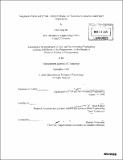Singapore's public and private transport modes : an economic comparison and policy implications
Author(s)
Ho, Chin Ning
DownloadFull printable version (60.77Mb)
Other Contributors
Massachusetts Institute of Technology. Dept. of Civil and Environmental Engineering.
Advisor
Mikel Murga.
Terms of use
Metadata
Show full item recordAbstract
Frequently, public decisions on transportation are based on cost benefit analyses that do not take into account the costs that private individuals are eventually led to spend in order to use these systems, even though these expenditures are sizeable. For FY2006-2007 in Singapore, we estimate that more than 90% of the S$34.4 billion to S$34.9 billion spent on the private automobile system were borne by private individuals. In contrast, only about 65% of the S$1.66 billion spent on the public transport system were borne by private individuals. The inclusion of private expenditures shows that the private automobile transport system costs society at least 20.7 times as much as the public transport system, even though 64% of all morning peak hour trips were made with public transport in 2004. Excluding time costs, private automobile trips cost S$2.05 per passenger-kilometer, or 14 times as much as public transport trips, which cost S$0.143 per passenger-km. Applying derived economic and time cost functions to each trip from the 2004 home travel survey data, we compared trips made among each of the 82 postal sectors of Singapore, and found that the economic costs to society for private car driver trips far exceed those made with public transport for all of the 1,906 postal sector combinations analyzed. Although the time costs for private car driver trips were substantially lower than those of public transport trips for almost all of the origin-destination pairs, these were not sufficient to offset the far higher economic costs to society. We have highlighted particular zonal combinations for which differences in economic, time, and total costs between private car driver trips and public transport trips were very pronounced, as these promise the largest potential benefits to society if the differences between public and private modes were bridged. (cont.) Therefore policies should be pursued to increase the share of variable automobile costs as a percentage of total costs. In parallel, other policy measures should include improvements of Rapid Transit System coverage specially along the corridors identified in this thesis, increases in road pricing, and actions to shift the burden of parking costs to private motorists.
Description
Thesis (S.M.)--Massachusetts Institute of Technology, Dept. of Civil and Environmental Engineering, 2008. Includes bibliographical references (p. 129-133).
Date issued
2008Department
Massachusetts Institute of Technology. Department of Civil and Environmental EngineeringPublisher
Massachusetts Institute of Technology
Keywords
Civil and Environmental Engineering.